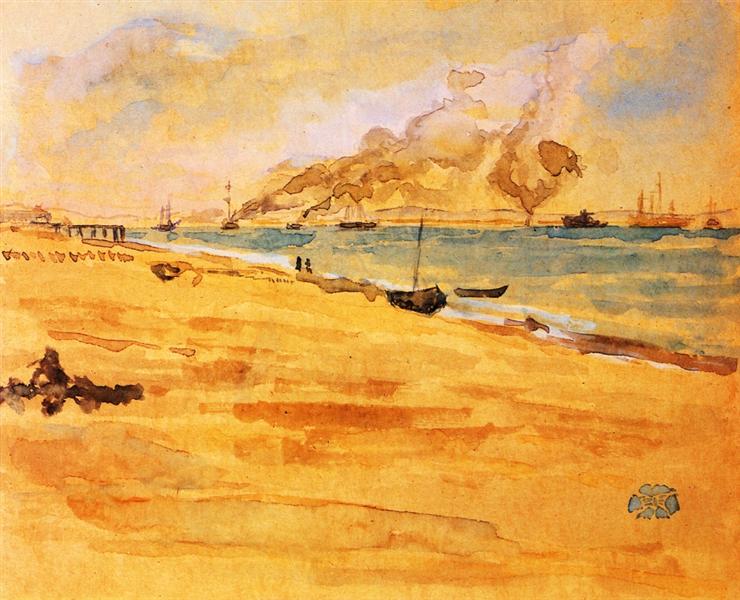Description
In the painting "Study for river mouth - 1877" by James McNeill Whistler, you can see the mastery of an artist whose approach is characterized by the search for harmony and subtility in each stroke. This work, although small and apparently simple, is a clear example of Whistler's interest in the exploration of landscapes, not only as representations of reality, but as compositions that suggest an atmosphere and a specific emotional state.
At first glance, the paint looks like a minimalist composition, with a restricted colored palette to bluish and gray tones that unfold on the canvas with aqueous fluidity. This monochromatic approach is a distinctive characteristic of Whistler's style, who sought to create chromatic "symphonies" that evoked a feeling of peace and contemplation. The use of color is so the dim and ethereal that it almost seems to disappear at certain points, allowing the viewer to concentrate on the general sensation rather than in details.
The landscape represented is the mouth of a river, and although the scene is essentially empty of human figures, a sense of presence implicit in the serene calm of water and the sky can be perceived. The horizon's line is almost imperceptibly melted in the distance, creating an illusion of infinity that is both relaxing and slightly disturbing. Whistler's choice to focus on natural elements with such a small technique allows the spectator to immerse himself in the scene, almost as if he were right there, observing the constant and silent flow of the river to the sea.
Whistler was a pioneer in the aesthetic movement of the nineteenth century, a precursor in the idea of "art for art." This philosophy proposed that the value of a work of art resides in its intrinsic beauty and not in its ability to tell an explicit story or promote an ideology. It is through works such as "study for the mouth of the river - 1877" that Whistler demonstrates his ability to capture the ephemeral essence of nature with a media economy that results in a deeply poetic work.
This study also reminds us of the subtle impact of Japanese influence on Whistler's work, visible on simplicity and in the way the composition is structured. The Ukiyo-E school, with its emphasis on the beauty of everyday life and its minimalist style, undoubtedly contributed to the evolution of Whistler's style. In this sense, his work becomes not only a window to the natural environment, but also a reflection on the purity of the form and elegance of simplicity.
In conclusion, "study for river mouth - 1877" by James McNeill Whistler is a work that, despite its apparent simplicity, contains a deep complexity in terms of technique and artistic philosophy. It is a masterful representation of how the media economy and the subtle manipulation of color and shape can result in an art piece that is both shocking and emotionally resonant.
KUADROS ©, a famous paint on your wall.
Hand-made oil painting reproductions, with the quality of professional artists and the distinctive seal of KUADROS ©.
Art reproduction service with satisfaction guarantee. If you are not completely satisfied with the replica of your painting, we refund your money 100%.

